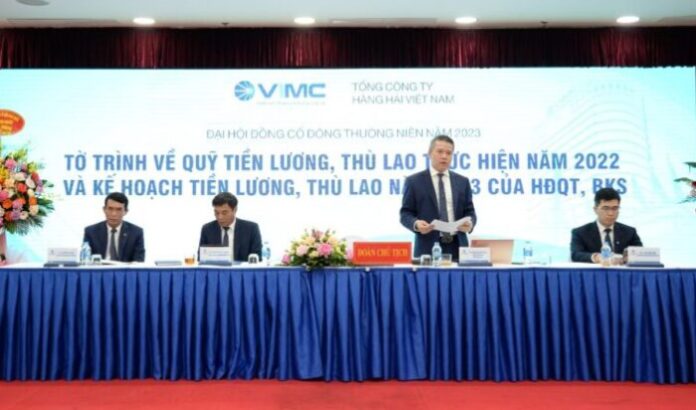
-
Vietnam Maritime Corp. shareholders approved VIMC’s plan to start a container transport company and divest its stakes in three units to focus on its shipping, port and logistics operations
-
The proposed VIMC Container Transport was approved during VIMC’s 2023 AGM on April 20
-
Capitalization of the new firm will come from the estimated US$1.86 million proceeds from divesting VIMC stakes in Hai Au Shipping, Sai Gon Maritime, and Vietnam High-tech Transport
-
Several other plans and targets, including stake divestment, capital contributions, and market share increase, also gained the shareholders’ approval
Shareholders have approved a plan by Vietnam Maritime Corp. (VIMC) to form a transport firm and exit three units to focus on core shipping, seaport, and logistics operations to offset revenue declines in other businesses.
The proposed VIMC Container Transport JSC was approved during VIMC’s April 20 annual general meeting, where several plans and targets, including stake divestment, capital contributions, and market share increase, also received approval.
This year, VIMC will divest its 26.46% stake in Hai Au Shipping, 10.15% in Sai Gon Maritime, and 56% in Vietnam High-tech Transportation Co. Ltd. Total proceeds from the divestments are expected to exceed 43 billion dong (VND) or US$1.86 million.
After approving the plan to form transport firm, shareholders also okayed around VND1.23 trillion or $53.47 million capital contribution – in Vietnamese dong – to form VIMC Container Transport, of which $45.21 million will represent the capitalization of VIMC Dinh Vu, including its two containerships and empty containers.
VIMC said it plans to contribute about $3 million to Saigon Port and $4.91 million to Cai Mep Ha Port, as well as increase its capital in a number of businesses, such as Vinaship and Vietnam Shipping Agency.
These moves will cut the number of firms with VIMC’s contributed capital from 35 to 27.
VIMC’s chief executive Nguyen Canh Tinh said 2023 is likely to be a very difficult year with more challenges than opportunities to offer, thus staying profitable is a good result.
“Increasing profits is not our top priority in 2023. There are still some goals that need to be achieved, such as expanding market share and increasing revenue outside our core activities,” he noted.
RELATED READ: Vietnam liner begins Malaysia-India service
Anticipating rough sailing in the global shipping market amid reduced demand, VIMC forecast an 18% year-on-year drop in shipping volume to 17.7 million metric tons at units VIMC Shipping, Bisco, and Vinaship.
In contrast, the seaport business expects volume to rise 9% y-o-y to 134.7 million MT, coming mainly at major ports such as Haiphong, Quy Nhon, and the joint venture seaport complex.
The shareholders’ meeting also approved the revenue and profit targets this year of $580.43 million total revenue, down about 13% y-o-y, and pre-tax profit of $101.3 million, down 24% y-o-y.
VIMC plans to continue to increase its external activities to offset revenue, focusing on three core business lines, namely shipping, seaport, and logistics.
For shipping, VIMC plans to liquidate 24 ships with a total tonnage of about 617,000 and invest in four containerships ranging from 1,700 twenty-foot equivalent units (TEUs) to 2,200 TEUs and eight dry cargo ships with maximum loads of 60,000 metric tons.
VIMC’s fleet is expected to grow 40 ships by 2025 with a total tonnage of about 1.2 million. Notably, the container fleet is expected to reach from 13,000 to 16,000 TEUs, equivalent to 30% of the nation’s total.
For the seaport business, VIMC will continue to develop the port system for large vessels this year, while studying and investing in seaport infrastructure in new locations, upgrading and expanding investments in existing infrastructure, and increasing its capacity and competitiveness.
In logistics, the company is expected to cooperate with different partners to invest and develop inland container depots and distribution and logistics centres in many areas such as Haiphong, Hanoi, Danang, Quy Nhon and Ho Chi Minh City.




